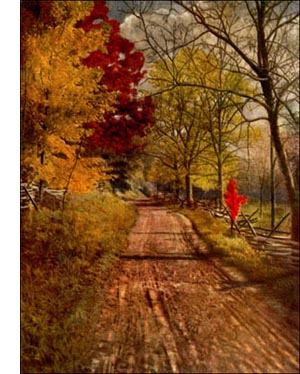Nutmeg Hickory Tree
 Nutmeg Hickory (H. myristicaeformis, Britt.) -A tall, straight tree, with narrow, open head, 80 to 100 feet high; branches stout, spreading. Bark reddish brown, broken into small, scaly plates; branchlets with golden scales. Wood heavy, hard, tough, light brown. Buds brownish, silky, hairy, small. Leaves 7 to 11 inches long, odd pinnate, of 5 to 11 leaflets, ovate-lanceolate to oblong-obovate, thin, firm, dark green, lustrous, silvery white beneath, sometimes pubescent; change to bronze in autumn. Flowers: staminate in catkins, 3 to 4 inches long, brownish pubescent, densely flowered, in threes; pistillate terminal, greenish, solitary or few, scurfy pubescent. Fruit small, with sweet kernel, in very thick shell, smooth, rounded, pointed at both ends, in thin, scurfy, hairy, 4-valved husk, with winged sutures that open almost to base at maturity. Preferred habitat, rich, moist soil of swamps, or river banks; sometimes dryer hillsides. Distribution, coast regions of South Carolina, central Carolina, central Alabama and Mississippi, southern Arkansas. Uses: Cultivated Sparingly in Eastern States. Beautiful ornamental tree. Locally used as fuel and lumber.
Nutmeg Hickory (H. myristicaeformis, Britt.) -A tall, straight tree, with narrow, open head, 80 to 100 feet high; branches stout, spreading. Bark reddish brown, broken into small, scaly plates; branchlets with golden scales. Wood heavy, hard, tough, light brown. Buds brownish, silky, hairy, small. Leaves 7 to 11 inches long, odd pinnate, of 5 to 11 leaflets, ovate-lanceolate to oblong-obovate, thin, firm, dark green, lustrous, silvery white beneath, sometimes pubescent; change to bronze in autumn. Flowers: staminate in catkins, 3 to 4 inches long, brownish pubescent, densely flowered, in threes; pistillate terminal, greenish, solitary or few, scurfy pubescent. Fruit small, with sweet kernel, in very thick shell, smooth, rounded, pointed at both ends, in thin, scurfy, hairy, 4-valved husk, with winged sutures that open almost to base at maturity. Preferred habitat, rich, moist soil of swamps, or river banks; sometimes dryer hillsides. Distribution, coast regions of South Carolina, central Carolina, central Alabama and Mississippi, southern Arkansas. Uses: Cultivated Sparingly in Eastern States. Beautiful ornamental tree. Locally used as fuel and lumber.It is the lustrous foliage that makes this tree the most beautiful of all the hickories. The deep, perpendicular roots that make transplanting a difficult matter among all the hickories have probably kept this one from the full recognition it deserves at the hands of nurserymen and planters. Its narrow range in sections that do not lack beautiful trees is another cause. In fact, the tree itself was not really discovered by a competent observer until 1890, although the nuts were seen by Michaux as early as 1802. The tree is rare in the Southeast, but is common in southern Arkansas. The fine specimen' in the garden of the Department of Agriculture at Washington proves its hardiness in that latitude, and brings its good qualities to the attention of the public.
Since we have all the hickories here in our Eastern States, it certainly behooves us to foster them, and share them with the rest of the world. The first step is to learn how best to propagate and transplant the various species. The next is to plant them freely, and so set forth their superior merits to all who see these plantations. There are few species which do not repay the cost in returns substantial as well as aesthetic. Hickory nuts and lumber are in constant demand, so each year adds to the value of the trees.